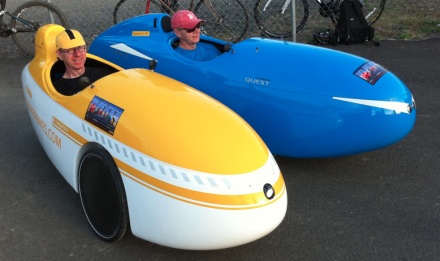
(Photos: Ted Buehler)
Portland is being invaded by velomobiles as we speak.
This Thursday, over 50, (nearly) fully-enclosed, pedal-powered machines will launch from Portland on a coast-to-coast tour. Organizers of the Roll Over America (ROAM) say it’s the first cross-country, group velomobile ride ever and it will, “be so unique that its participants will find it virtually impossible to escape public attention.”
Velomobiles are three-wheeled recumbents wrapped in an extremely aerodynamic shell made of fiberglass, carbon fiber or aluminum. They might look like rocket ships, but they’re street legal and meant for everyday use. The bright paint is a way to increase visibility — something they need being so close to the ground.
“If you are shy, riding a velomobile will be a bad idea,” says ROAM tour organizer Josef Janning.
They are definitely hard to miss. A few of them rolled out to Portland International Raceway last night and instantly drew a crowd…
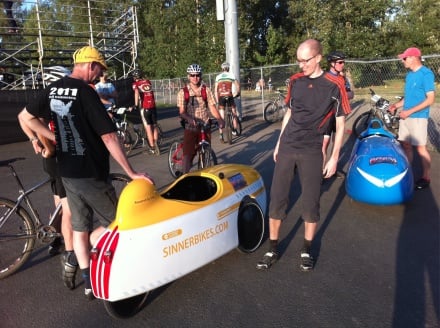
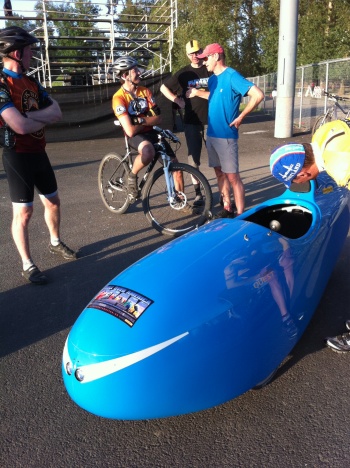
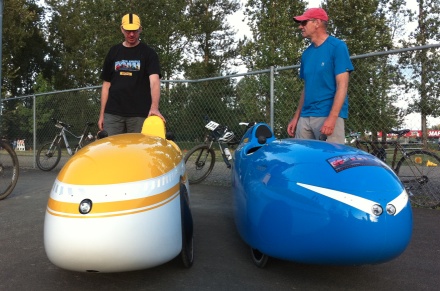
ROAM riders hail from all over Europe and America. Their journey will take them through 15 states and they plan to cover the 3,000-plus mile distance in four weeks at an average of about 125 miles per day. They’ll cruise along at speeds between 20-30 miles an hour without even breaking a sweat.
Beyond just a display of physical prowess, the tour is also about promoting the idea of velomobiles and the vast potential they offer for the future of human-powered transport.
Just ask U.S. Congressman Earl Blumenauer. In a statement from ROAM organizers, Blumenauer called the event, “An exciting tour that will showcase the benefits and practicalities of velomobiles for long-distance travel as it brings national visibility to the health, fuel-efficient, and environmental value of human-powered vehicles.”
Velomobile advocate Craig Johnsen says that as energy prices rise, “human powered vehicles could become a more-usual sight on American roads and trails.”
On Thursday, all 50 of the ROAM tour participants will roll en masse down to the Salmon Street Fountain. They expect to arrive between 10:30 and 11:00. They’ll stick around for an a few hours to take questions and pose for photos. As for test rides? I wouldn’t count on it; but maybe if you ask very nicely.
If all goes according to plan, they’ll be presented with an official proclamation of “Velomobile Day” by the City of Portland Office of Transportation.
You can learn more about the ROAM tour and follow updates RollOverAmerica.eu.



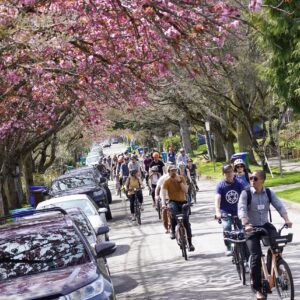
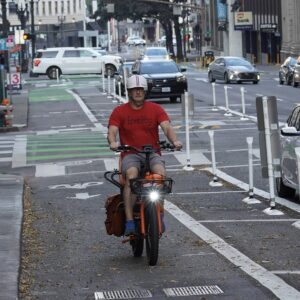

Thanks for reading.
BikePortland has served this community with independent community journalism since 2005. We rely on subscriptions from readers like you to survive. Your financial support is vital in keeping this valuable resource alive and well.
Please subscribe today to strengthen and expand our work.
Weren’t these guys in a Woody Allen movie? Oh wait, those were sperm.
I recall (but can’t find) a discussion about the efficiency of these machines at different speeds: the relationship between the benefit: reduced drag and the cost: extra weight. Can anyone recall the details? It seems that they come into their own at high speeds, yes?
This is one of the better resources for background info: http://users.telenet.be/fietser/fotos/VM4SD-FVDWsm.pdf
I can’t find the link to a much more thorough series of coasting tests of upright vs recumbent vs fully faired recumbent. It showed the obvious (that the extra weight is a stiff penalty going up hills) but that the inertial energy released going downhill is not lost to air drag as quickly thus allowing for a higher average speed even on hilly routes. There were MANY charts and much mathematical detail.
I seem to remember this article was an html page but it may have been a pdf.
A rather brief technical article (13 pages) Streamlined HPV technical papers by Nick Hein at recumbents.com’s HPV R&D page.
http://users.telenet.be/fietser/fotos/VM4SD-FVDWsm.pdf
The above link will give you the info you seek.
I was riding home from the grocery store with 30 to 40 lbs of groceries and gear in my velomobile. On level ground I was traveling at 30 + mph. I had to take a sharp, just about 180 degree, right hand turn onto another road. A very fit, seriously competitive cyclist I know on a very top of the line road bike had taken a left hand turn onto the same road just after me. I did not notice him until I had made my turn. He got to with in 20 to 30 feet off of my rear, standing on those pedals with everything he had as I was spinning my 83 lb velomobile, loaded to the gills with groceries with my 230 lb arse in the cockpit. He held that distance for perhaps 15 seconds until I passed 25 mph and kept on accelerating. And then he was gone. One other point to mention is that that cyclist is 25 years younger than me. It’s all about aerodynamics.
David & Taylor,
thanks for linking to that fascinating report. I really enjoyed it. Maybe Jonathan can do a story on this all by itself? So much good stuff in that paper.
Re “fully-enclosed,” it looks like the top of the cabin is open, no? Having some sort of flip-top cabin might be nice (i.e., increase ridership) for the Portland weather…
Re “cruise along at speeds between 20-30 miles an hour without even breaking a sweat,” literally? I can break a sweat on a bike at 15mph, but I sweat a lot. Are they super light or something? How much do they weigh?
it’s all about aerodynamics !! Whether through air or through liquid… Power required goes up with speed^3 !.. That’s why going slower saves energy, whether on land air or sea. for example it is easier to go from 10 to 15 mph then it is to go from 28 to 29 mph !
That’s why aerodynamics are so important. and if you streamline the vehicle, the energy savings, especially up at any sort of speed, are large.
For example, Loremo is to make a 4 seat production car. It will get 100-150 mpg, obvious KISS design principle with just good aerodynamics and a simple clean 20 hp diesel. Low initial cost also. ..and top speed is over 100 mph!
If i ever have a long commute, I am definitely going to check out getting a recumbent with a fairing !
“It’s all about aerodynamics !!”
Yes and no. the point I think is that you get the improved aerodynamics at a cost: weight penalty. Below a certain speed the aerodynamic benefits are not felt, because drag is also a function of speed.
Yes, sorry what i should have said is :its all about aerodynamics unless your relative speed through the air (ie head wind / tailwind) is under say 10 mph . or obviously if you are climbing a lot.
The weight is a cost but one that is well worth the price. I spin a high cadence and keep it there regardless of up or down. I’ve ridden a very casual 142 miles in 8.5 hours.
Last year I rode a 62 mile/100km MS Ride. I started mid pack of 350 cyclists. It took me 6 miles to get off the front along with passing the pace (police) car.
From around 10 miles to 30 miles into the course were the hills. The 2nd big hill I was caught and passed by 30 to 40 cyclists. By 22 miles I had caught and passed all but 8 of those riders who were riding as a team. Those 8 cyclists and I went back and forth for the lead until the 28 mile mark and then they were gone.
I had a maximum speed of 44 mph and an average of 19.9. 3 hours and 6 minutes.
The same ride this year, though 2 miles longer at 64 miles because of road work, I started off the front and blew by the pace(police) car right off the line. On the same hill I was caught on last year, I was caught by 5 cyclists not 30 to 50. Same maximum speed but a higher average at 20.65 mph. 3 hours and 5 minutes this year. I wonder what I could do on level ground?
They have optional tops generally. Usually folks don’t run with them though, unless they are racing as apparently you don’t get too wet as they all (As far as I know) come with kayak-style skirts which stow away inside them so only your head is out in the rain of very cold weather.
A lot of the newer designs weigh around 60 lbs, but that with full suspension, extremely bright running and tail lights, turn signals, USB ports (No joke), etc.
Excellent pictures and coverage of ROAM, thanks for the update. It is nice to see Harry on the left in the yellow mango. I am not sure who is in the blue quest.
The blue Quest belongs to Josef. He is standing beside it wearing the blue shirt.
I wonder if they are hot boxes…given their summer time tour? No AC of course. 😉
LOL, ‘without breaking a sweat’.
I’m pretty sure it’s hot in those things when you’re pedaling in the summer, there’s a lot more ventilation on an upright/open bike.
They are pretty cool inside in the sun when you are moving, as the majority of your body is in the shade. However, at stops they heat up pretty quick.
Many of the velomobiles have tops that are removable. Mine is one http://www.flickr.com/photos/wmbates/2686160203/in/set-72157606278595406
A closed Quest takes roughly 220 watts to do 30mph or 108 watts to do 20 mph on flat ground. A triathlon bike would use around 436 watts to do 30mph and 153 watts for 20 mph. Both sets of figures are using a rider weight of 156 lbs. Numbers were figured using this online Bicylce Speed and Power Computer
http://hembrow.eu/personal/kreuzotter/espeed.htm
Many velomobiles weight between 70-80 pounds. The (fiberglass) Quest is listed at 38kg. The carbon fiber Quest weighs less. Clean and empty my velo weighs 80lbs give or take a little.
Kewl. Thanks!
A velomobile has decent airflow and puts the rider in the shade. The shade is quite nice. My Mango Sport velo weighs 65lbs. Some of the velos above are all carbon and weigh less than mine.
Looking forward to meeting these riders Thursday morning for a Portland style send-off.
Welcome to Portland, Velomobiles! It was a treat to see you at the track last night.
Ted Buehler
And I have to work until 3:30 on Thursday. Dang!
Do any of these come as tandems?
If the surface of the velomobiles had dimples life a golf ball, they’d go faster.
Nah.. why would you want to induce turbulant flow? As long as there isn’t seperation, Laminar flow has less drag.
That is, unlike a golf ball, a velomobile doesn’t spin while in motion—I don’t think.
Type “dimpled car” and “mythbusters” into google to find the episode where they got 29 mpg from a 26 mpg ford taurus by adding clay dimples to its surface. Here’s one link regarding the episode: http://www.landracing.com/forum/index.php?topic=6955.0
comparing apples to oranges. In some cases turbulent flow may help. For sphere it helps. for a shark or a bird, jet, etc, where the shape is more teardrop already, it doesn’t… so possibly for a taurus it helps.
so yes if you bought those dimpled carbon rims, well placebos work too. 🙂
Tandem-ish. Check out
http://www.recumbentblog.com/2009/06/19/a-velomobile-built-for-two-or-more/
Yeah, I have to work Thursday afternoon, but then I’m going to drive out to Cascade Locks to meet them at the end of that day. After that, they’re off to Montana and point east.
This is really cool.
But, they are here like for a couple of days, and then get their own day?
I have been riding here for eons. I don’t have a day yet….
The above comment is to be taken as lightly as possible…
This is America … every day is Me First Day.
If you want to see how velomobiles compare to bikes check this YouTube video out:
http://www.youtube.com/user/nitramluap#p/u/8/8zeuZbpN7c8
I rode behind these guys on my way home today, other than being distracting, they were horrible to follow. No indication of slowing down, turning, etc. And they are so low, they are hard to see, there was one “soap box derby car” that had a tall flag and it was at the back of the pack. Cruising through Portland at rush hour did not seem like a wise decision to me.
My trike is far lower, and I get *wildly* more room from cars than my old upright. There is no problem with visibility at all.
Absolutly. I agree.
Most of the velomobiles have turn indicator and brake lights, and usually the rider would use that to signal – I don’t know why they did not in this instance. So I do not think that this is usually an issue.
My Quest has a brake light and turn signals and even so I ride with 3″ wide bright orange ankle wraps on my wrists to make my intention even more evident. Sad to say, I have been passed by motorists on the left dozens of times when I am signaling with my arm out and lights flashing. I also run with mirrors and use them.
I hate to say this but I see very few motorists that use their turn signals at all and many who do so when they are half way through the turn already. When I learned to drive, the rule of thumb was to turn on your signal 500′ before the turn.
Well, what do you expect from tourists? Half (maybe more than half) are from Europe, so of course they’re going to stop and take in the sights.
Plus they are use to dealing with motorists who know how to drive.
You might as well put an electric motor in them along with the flip top so people can get them up hills easily. And then, call it a “car”.
You might well as dismiss any idea that is different.
Different is bad; Big Brother likes conformity.
What fun is that?
Oklahoma’s own. Have a safe trip, Franz! http://pterovelo.com/
There is a nice review of these type of shuttles done by Kris De Decker at the Low-Tech magazine http://www.lowtechmagazine.com/2010/09/the-velomobile-high-tech-bike-or-low-tech-car.html
Thanks, Jeff. That answered my question–and I quote:
“By definition, velomobiles are built for speed. The bodywork offers a distinct advantage at higher speeds, starting at 20 to 25 km/h (12.4 to 15.5 mph). Above those speeds, almost all energy produced by a cyclist is channelled toward combating air resistance. Because of the upright position, the aerodynamics of a cyclist on a normal bicycle are disappointing. A velomobile, on the other hand, suffers less air resistance than even the most aerodynamic sports car.
At lower speeds, however, the relatively heavy (25 to 40 kilograms) velomobile becomes a disadvantage. It accelerates slower than a normal bicycle, and has considerably more difficulty climbing a hill.”
This is 5 years old now, but I wanted to comment. What I find interesting is the apparent disdain by a large number of velo drivers(?) for adding an assist electric motor to help with that off the line and hill climbing. Many go so far as to call any velo with one “not a velo”. Which is strangely intolerant for those promoting an “alternate” form of transportation.
You take your time getting up to speed rather than trying to drag race it light to light. Once at speed they just roll and roll… On downhill grades that you might hit mid 30’s on a regular bike, some of these can coast past 50-60mph and some riders will deploy small drag chutes to keep the speeds reasonable without melting down the brakes. The 24 hour human powered record is now held by a 54 year old German riding a Milan velomobile… at over 35mph average speed and 760 miles (around a track). An athlete in his mid 50’s riding a vehicle designed for riding on the street for normal transportation. A team of older recumbent riders a couple of years ago smoked the Ride Across Oregon using a Quest in the mountains where his speed on the descents was in excess of 50mph in the dark and his momentum was carrying him over many of the grades.
Lance Armstrong wore dimpled time trial suits because they saw benefits in the wind tunnel.
“Discussion threads on several auto forums discussing the Mythbusters episode note that “shark skin” textures on military fighter aircraft (and on America’s Cup yachts) serve the same purpose, that dimpling on the undercarriage of some Lexus cars reduces noise (by reducing friction), and that textured paint is banned on professional race cars.” from here: http://www.neatorama.com/2009/10/23/can-you-improve-your-cars-gas-mileage-by-adding-golf-ball-dimples/
Once again for a human body / wierd shape, inducing turbulent flow may help.
Shark skin / textured paint is not the same as dimples..
It all depends on the particular situation / design…
Jeff,
lower speeds for a velomobile are <10mph. It is surprising how easy it is to get a velomobile to 15mph from a dead stop. So climbing faces penalties but on grades less that 3% a velomobile still does quite well.